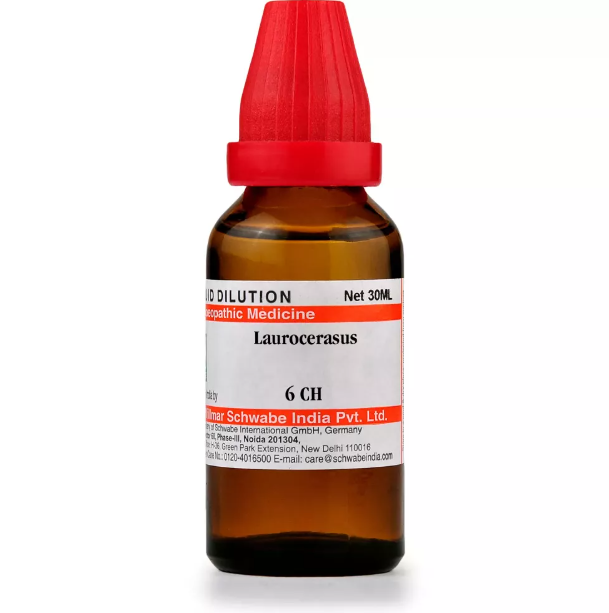LAUROCERASUS Q, 6C, 12C, 30C, 200C, 1M, 10M USES AND SYMPTOMS
 LAUROCERASUS
LAUROCERASUS
(Cherry Laurel)
Laur.
Spasmodic tickling cough, especially in cardiac patients, is often effectively influenced by this drug. Lack of reaction, particularly in chest and heart conditions. Drinks are audibly swallowed through the esophagus and intestines. General coldness, not improved by warmth. Violent stomach pain with loss of speech. Spasm of facial muscles and esophagus. Asphyxia neonatorum.
Respiratory: Cyanosis and dyspnea; worse when sitting up. Patient puts hands on the heart. Cough with valvular disease. Exercise causes pain around the heart. Tickling, dry cough. Dyspnea (asthma). Chest constriction. Cough with copious, jelly-like or bloody expectoration. Small and weak pulse. Threatening lung paralysis. Gasping for breath; clutches the heart.
Heart: Mitral regurgitation. Clutching the heart and palpitations. Cyanosis neonatorum.
Extremities: Toe and finger nails become knotty. Skin blue (cyanosed). Sprained pains in hips, thighs, and heels. Cold, clammy feet and legs. Clubbing of fingers. Veins of hands distended.
Sleep: Deep sleep spells, with snoring and heavy breathing.
Fever: Coldness; alternating chills and heat. Thirst, with a dry mouth in the afternoon.
Relationship: Compare: Hydr-ac., Camph., Sec., Am-c., Ambr.
Dose: Tincture to third potency. Cherry laurel water, two to five drop doses.
SYMPTOMS OF LAUROCERASUS
Respiratory:
Cyanosis and dyspnea, worse when sitting up.
Patient places hands on heart.
Cough associated with valvular disease.
Exercise-induced heart pain.
Tickling, dry cough.
Dyspnea (asthma), chest constriction.
Cough with copious, jelly-like or bloody expectoration.
Weak, small pulse.
Risk of lung paralysis.
Gasping for breath, clutching the heart.
Heart:
Mitral regurgitation.
Heart clutching and palpitations.
Cyanosis in newborns.
Extremities:
Knotty toe and finger nails.
Cyanotic skin.
Sprained pain in hips, thighs, and heels.
Cold, clammy feet and legs.
Clubbing of fingers.
Distended veins in hands.
Sleep:
Episodes of deep sleep with snoring and heavy breathing.
Fever:
Alternating chills and heat.
Thirst with dry mouth in the afternoon.
selection of the potency
Individualization:
- Homeopathy is based on the principle of treating the individual, not just the disease. The unique symptoms and characteristics of the person are crucial in determining the most suitable potency.
Intensity of Symptoms:
- The intensity of the symptoms guides the choice of potency. If the symptoms are intense and acute, a lower potency (e.g., 6C, 30C) might be considered. For chronic conditions with less intensity, higher potencies (e.g., 200C, 1M) may be appropriate.
Sensitivity of the Patient:
- Some individuals are more sensitive to homeopathic remedies, while others may require higher potencies. The practitioner considers the patient’s sensitivity when selecting the potency.
Acute vs. Chronic Conditions:
- Lower potencies are often used for acute conditions, while higher potencies may be considered for chronic or long-standing issues.
Previous Response to Potencies:
- The patient’s response to previous homeopathic treatments helps guide the choice of potency. If a particular potency has been effective in the past, it may be repeated or adjusted as needed.
Vital Force and Susceptibility:
- Homeopathy views illness as a disturbance in the vital force. The practitioner assesses the patient’s overall vitality and susceptibility to determine the appropriate potency.
Aggravation or Amelioration:
- The direction of the symptom response (aggravation or amelioration) after taking a remedy can influence the choice of potency.
Miasmatic Considerations:
- In classical homeopathy, the concept of miasms (inherited disease tendencies) is considered. The practitioner take this into account when selecting the potency.
Practitioner Experience:
- The experience and preference of the homeopathic practitioner play a role. Some practitioners may have success with certain potencies based on their clinical experience.
SAFETY INFORMATION
- Do not exceed the recommended dose by physician
- Keep out of the reach of children
- Store in a cool dry place away from direct sunlight
- Maintain half an hour gap between food/drink/any other medicines and homoeopathic medicine
- Avoid any strong smell in the mouth while taking medicine e.g. camphor, garlic, onion, coffee, hing
Medicine images use for reference only selection of homeopathic medicine depends on the individual’s specific symptoms and overall constitution. Moreover, homeopathy is a holistic system of medicine that treats the individual as a whole. In addition to addressing the physical symptoms, it takes into account the emotional and mental state of the person. Consequently, it’s crucial to consult with a qualified homeopathic practitioner for personalized treatment.
The information provided on this website is intended solely for educational purposes. Always seek the advice of your physician or other qualified health provider.
